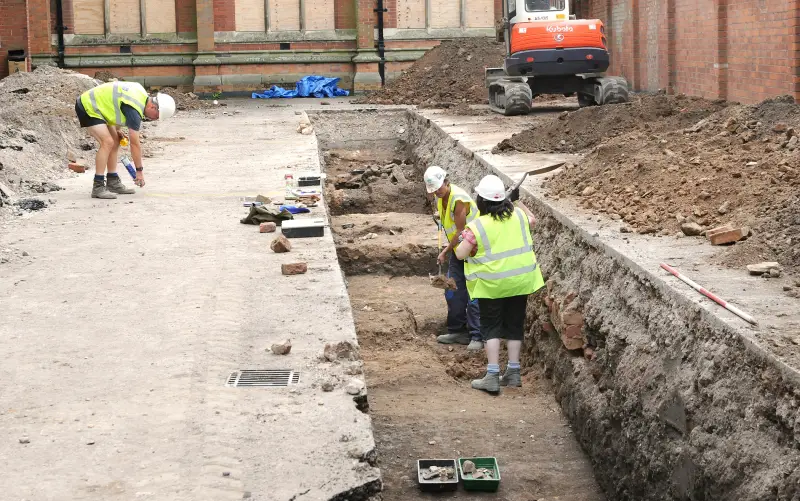These are architectural fragments from the friary buildings. Credit: University of Leicester
Archaeologists from the University of Leicester who are leading the search for King Richard III have announced they have overcome the first significant hurdle of their investigation – and made a huge step forward in the search for the King by locating the church where he was buried.
The University of Leicester is leading the archaeological search for the burial place of King Richard III with Leicester City Council, in association with the Richard III Society.
In 1485 King Richard III was defeated at the battle of Bosworth. His body, stripped and despoiled, was brought to Leicester where he was buried in the church of the Franciscan Friary, known as the Grey Friars. Over time the exact whereabouts of the Grey Friars became lost.
The project which began over a week ago has involved digging of two trenches at a council park- and this week a third trench was excavated.

Lead archaeologist Richard Buckley, Co-Director of University of Leicester Archaeological Services, said: “The discoveries so far leave us in no doubt that we are on the site of Leicester’s Franciscan Friary, meaning we have crossed the first significant hurdle of the investigation.
“It is remarkable that the third trench has now made us certain that we have located the Friary church – not only a huge step forward in the search for the remains of Richard III, but also important new evidence for one of Leicester’s major religious buildings, lost for over 400 years.”
Earlier this week, the archaeological team – dubbed by the local media as the ‘Time Tomb Team’ – extended the trenches to clarify the alignment of some of the walls that had been revealed.
Mr Buckley said: “We now think we have evidence for a two-metre wide north-south passageway which originally had a tiled floor -this may be a cloister walk on one side of a cloister garth or courtyard. At right angles to this is an east-west aligned building some five-metres wide, again with evidence for a tiled floor.”

“To the north of it there seems to have been an open space, but then another substantial east-west building represented by a robbed wall around 1.5m thick. This wall is a candidate for the south wall of the church, so on Saturday, a third trench was laid out in an adjacent car park to see if it continued to the east. After modern layers had been machined off, this wall was indeed picked up, together with another one around 7.5m to north, with a mortar floor (probably originally tiled) in between them.
“The size of the walls, the orientation of the building, its position and the presence of medieval inlaid floor tiles and architectural fragments makes this almost certainly the church of the Grey Friars.
“The next step- which may include extending the trenches- will seek to gain more information on the church in the hope that we can identify the location of the choir and high altar. Finding the choir is especially important as this is where Richard III is recorded as having been buried.”

Mr Buckley added: “At the beginning of the project, I cannot say I was completely confident about finding the remains of the Friary, let alone getting closer to the presumed burial place of Richard III. The trenches could easily have missed the structures we have found, had they been located differently, or we could have found that the evidence had already been destroyed by later development on the site.
“The whole team has been fired up by the project and we are extremely excited by the prospect of further discoveries over the next week or so which may take us closer to our goal.
“With or without the burial place of Richard III, the investigation has been extremely rewarding and makes a significant contribution in terms of telling the story of medieval Leicester. I am delighted that the University of Leicester is playing a pivotal role in the telling of that story.”
Contributing Source : University of Leicester
HeritageDaily : Archaeology News : Archaeology Press Releases






